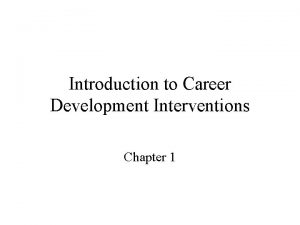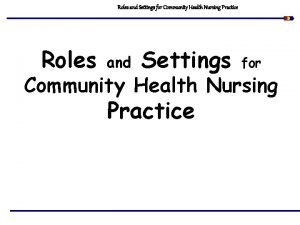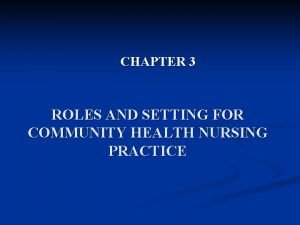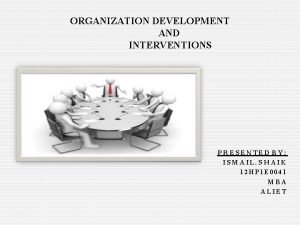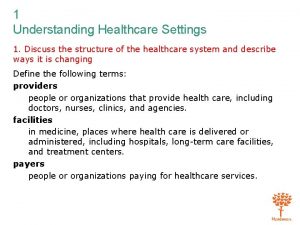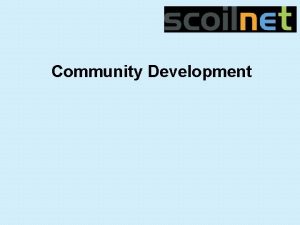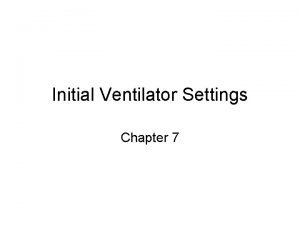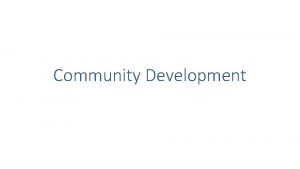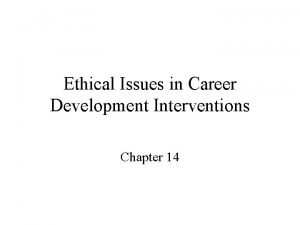Career Development Interventions in Community Settings Chapter 13













- Slides: 13

Career Development Interventions in Community Settings Chapter 13

Introduction • Community-based counseling has had a long struggle for recognition, though Parsons’ Bureau in Boston was communitybased. • School counseling was the first specialty to be recognized -- in the National Defense Education Act of 1958.

Introduction • The American Personnel and Guidance Association (now the American Counseling Association) was formed in 1952 by four specialties, not including community-based. • ACA currently has 17 divisions, but none that specifically represents communitybased counselors.

Qualifications of Professional Counselors • Counselor education programs may be approved by the Council for Accreditation of Counseling and Related Programs (CACREP), which has high standards. • Individuals may be certified by the National Board for Certified Counselors (NBCC). • In addition, counselors may hold state licensure, required in 49 states.

Definition • Community counseling is the application of counseling principles and practices in agency, organization, or individual practice settings that are located in and interact with the surrounding community.

Competencies • All professional counselors are trained in the same 12 basic competencies. • Community counseling requires skill in four additional competencies -- coordination, consultation, advocacy, and case management.

Coordination • This is a process of bringing together the needs of a client and resources of the community. • Schlossberg’s 4 -step model provides a helpful framework for identifying client strengths and barriers.

Coordination • Counselors need to identify community resources available and know them well. • Working with a client is a 5 -step process: – Identify client needs. – Match client needs and community resources. – Introduce client to the resources. – Refer the client. – Follow through with the client.

Consultation • Consultation is the work of one professional with another in an attempt to find ways to reach compromise that will address the needs of a third party (the client).

Advocacy • Advocacy is the act of exerting pressure on some aspect of the community in order to improve the resources available to clients.

Case Management • Its goal is to assure that a client receives the sequence of services needed in a timely and coordinated way. • Its instrument is the case plan. • Its tasks include coordinating, sequencing, communicating, and following through.

Community Counseling and Other Specialties • Similarities – Practice draws on the same base of counseling theory. – Counselors deal with similar client problems. • Differences – Community counselors deal with adults. – Options are limited to those in community. – Counselor may spend equal time with client and resources. – Work setting is the community.

Typical Work Settings • • Private practice The World Wide Web (cybercounseling) Mental health centers Substance abuse centers Rehabilitation settings Corrections and probations Job Service offices and one-stop centers Corporations and other organizations
 Career development interventions
Career development interventions Roles of community health nursing
Roles of community health nursing Community settings main roles
Community settings main roles Main roles of community setting
Main roles of community setting Organizational development interventions examples
Organizational development interventions examples Community development background
Community development background Chapter 9 career planning and development
Chapter 9 career planning and development Chapter 9 career planning and development
Chapter 9 career planning and development Chapter 9 career planning and development
Chapter 9 career planning and development 16 national career clusters framework
16 national career clusters framework Formulas for career success: résumés - assessment
Formulas for career success: résumés - assessment Chapter 1 understanding healthcare settings
Chapter 1 understanding healthcare settings Creed of fccla
Creed of fccla Chapter 6: career readiness
Chapter 6: career readiness
